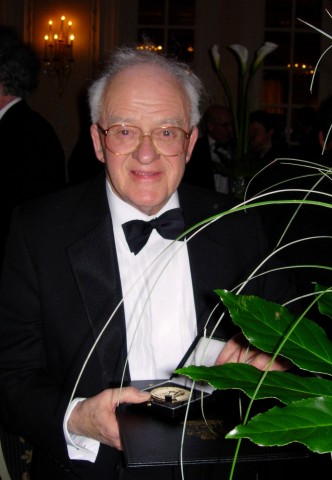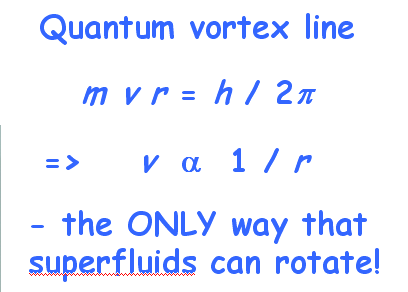Guthrie Medal and Prize
Joe Vinen - for many years the leader of the Condensed Matter Group in Birmingham, and still very active - was awarded the 2005 Guthrie Medal and Prize by the Institute of Physics.
Joe came as Professor of Physics to Birmingham University from Cambridge in 1962. He became Poynting Professor of Physics in 1973 and Emeritus Professor in 1997. His work is characterised by elegant experimentation carried out with care and rigour, formidable theoretical analysis and penetrating physical insight.

Joe Vinen with the Guthrie medal at the Savoy hotel in London
Joe Vinen's research career has centred on superfluids and superconductors. With H E Hall, he made the experimental discovery of quantized vortices in superfluid helium. His subsequent direct mechanical observation of the quantization of the strength of one of these vortices was the first confirmation of the application of quantum mechanics to a macroscopic body [1].

A quick reminder of the physics of a quantum vortex

An example of a classical vortex, the water in your bathtub!
This discovery of major significance was followed by extremely productive research into analogous structures in superconductors: quantised lines of magnetic flux. Joe Vinen then turned to two other techniques for the study of superfluids:
Joe Vinen's current interests centre around turbulence in superfluids, where the motivation is to discover analogies with turbulence in a classical fluid, and thereby gain a deeper understanding of both. This has involved experiment, theory and simulation, often in productive international collaborations, to show how the flow of turbulent energy from large scales to small scales, with ultimate dissipation as heat, can occur through non-linear effects in both the classical and the quantum systems [4,5]. An important factor is 'Kelvin waves', which are modes of vortex vibration.

Simulation of a tangle of turbulent vortices in superfluid Helium

A 'Kelvin wave' visible on a tornado
Joe has received many awards in recognition of his achievements, including, the Simon Memorial Prize of the Institute of Physics in 1963, Fellowship of the Royal Society in 1973, the Holweck Medal of the Institute of Physics and the French Physical Society in 1978, the Rumford Medal of the Royal Society in 1980, and Honorary Fellowship of the Institute in 2003.
[1] W.F. Vinen "Detection of single quanta of circulation in rotating helium-II", Nature 181, 1524 (1958) - and at more length in: Proc. Roy. Soc.A 260, 218 (1961).
[2] W.F. Vinen and D. Hurd "Light Scattering studies of the dynamical behaviour of liquid He4 close to the lambda-line", Adv. Phys. 27, 533 (1978).
[3] C.F. Barenghi, C.J. Mellor, J. Meredith, C.M. Muirhead, P.K.H. Sommerfeld and W.F. Vinen, "Ions trapped below the surface of superfluid helium: the observation of plasma resonances and the measurement of effective masses and ionic mobilities", Phil. Trans. Roy. Soc. A 334, 139-172 (1991).
[4] W.F. Vinen "Classical character of turbulence in a quantum liquid", Phys. Rev. B 311, 1396-1409 (2000).
[5] W.F. Vinen, M. Tsubota and A. Mitani "Kelvin-wave cascade on a vortex in superfluid He4 at very low temperature", Phys. Rev. Lett. 91, 135301 (2003).